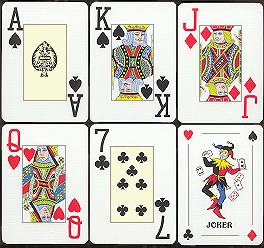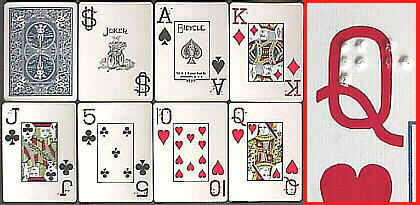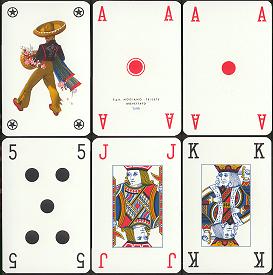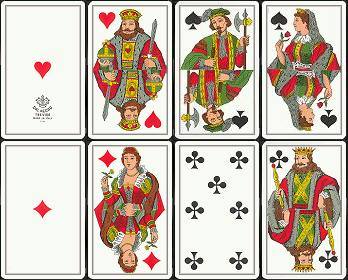This page illustrates some varieties of the international pattern (i.e. the 52-card pack
with French suits), which are not fancy patterns nor regional ones, but difficult
to classify else than "varieties". They were designed for specific purposes, although
any game could be played with most of them.
BLACK JACK OR LARGE INDEX CARDS
Large index cards are the most common type. They consist of an ordinary
pattern, whose central illustrations are slightly reduced in size and framed by a line,
while the indices, usually two, are quite larger than the usual ones. In some editions
the pip cards have a background coloured in light shades (pale grey, pale yellow, etc.)

large index Pingüim brand, by SO.IM.CA. (Brazil) |

large index deck by Falcon (UK)
These decks are often adopted by low-sighted players for generic games such as
Poker or Bridge. But the main purpose they were created for, not long ago, is to be used for
Black Jack and similar casino gambling games, in which the banker often sits at a
certain distance from other players. |
500
500 is the national card game of Australia, but it is also played in New Zealand and the United States. The game was in fact devised in the latter country, based on the more popular Euchre. The special deck found in Australia has 63 cards, 62 of which are suit cards and one is a joker. The red suits (Hearts and Diamonds) have sixteen cards each, with pip cards running up to 13, while the black suits (Diamonds and Spades) have fifteen cards each, with pip cards running up to 15. These extra values, i.e. 11s, 12s and the red 13s, are the only oddity of the deck, whose aces, courts and single joker are standard. Furthermore, the extra pip cards are only used for the six-player variant of 500, being the most common one played by four. |
 |
BRAILLE INDEX CARDS
Bicycle (USA) manufactures a deck which has Braille indices (in relief)
overlapping large size printed ones.
This enables blind players to enjoy any kind of game played with a standard deck.
Each card can be told by two characters, the first one indicating a value
(numeral or court), while the second one shows the suit.
In Braille, numerals are spelled in the same way as the first
letters of the western alphabet (i.e. 1=A, 2=B, 3=C, etc.). |

Braille index deck by Bicycle (USA) |

indices and values expressed in Braille |
Therefore, "2C" (or "BC") would be the index for the 2 of Clubs, "KS" for the
King of Spades, "4D" (or "DD") for the 4 of Diamonds, and so on. Since 10 has two
digits, the index for this value is "X", as in roman numbers. The joker card
is spelled "JO", to distinguish it from jacks ("J").
|

Canasta deck by Modiano (Italy) |
CANASTA CARDS
This variety is specifically produced for playing Canasta, a game born in Latin America
in the early 1900s, which rapidly spread to most other parts of the world during the
first half of the century.
In Canasta no difference is made between Hearts and Diamonds (the red suits), nor between
Spades and Clubs (the black ones): the suit signs have been turned into round dots of the
two colours, not much different from domino pips, while the courts have been simplified by
adopting only three subjects for each colour. The four indices are the ordinary ones.
Canasta cards include two jokers per deck (for a total of six). |
The only two editions I am presently aware of are made by the Italian manufacturers Dal Negro
and Modiano.
Minor differences can be told between them. For instance, in Modiano's version
one of the two red aces has an outline, thus being distinguishable from the other red ace
(although this is of no use in the game), the courts are small, as in the aforesaid
large index cards, and the joker's character carries a basket (canasta in Spanish).
Dal Negro's edition, instead, has an ordinary joker, but the ace's dot is larger, all pips
are decorated, and the courts have a grey background.
Since for playing Canasta three packs are needed, this pattern only exists in 162-card sets,
equivalent to a triple 52 + 2 J pack.
|

Canasta deck by Dal Negro (Italy) |
 |
Up to 1972, the year in which the duty for Italian playing cards to bear a tax stamp came to an end, also Canasta decks were subject to this rule; the stamped subject was the usual one, i.e. the ace of Hearts, which in this particular pattern has the aforesaid shape of a single red dot with a red outline.
stamped Canasta ace, edition by Modiano |

Trente et Quarante deck by Dal Negro (Italy) |
TRENTE ET QUARANTE CARDS
This is another kind of pattern related to a specific game, Trente et Quarante ("Thirty and
Forty"). In this case the illustrations are not the same ones as in international decks,
but they are not fancy nor regional ones.
The game was born in France, probably around the late 17th or early 18th century.
A banker deals face up two cards at a time, arranging them into two rows called Rouge
and Noire (red and black), until the sum of the cards in any of the two rows reaches 31 points or more.
If both Rouge and Noire do so at the same time, the one closest to 31 wins. |
The game is entirely based on bets, and vaguely reminiscent of the
roulette scheme: players do not actually receive cards in hand, but simply
place their bet on whether the red row or the black one will first reach 31, and whether
this will happen with a red-suited or black-suited card.
The game is popular in France, but it is also played in several other European
countries.
Most Italian manufacturers produce a specific Trente et Quarante pattern, somewhat
similar to the Italian Lombarde and Piemontesi (see Italian gallery).
Neither pip cards nor courts have indices, and no jokers belong to the pack.
Also the size of the cards is close enough to regional patterns, being slimmer and slightly
smaller than average Bridge or Poker decks.
|

Trente et Quarante deck by Modiano (Italy)
|
OTHER GALLERIES






















or back to

INTRODUCTION
AND HISTORY
|

MULTI-LANGUAGE
GLOSSARY |

THE FOOL &
THE JOKER |

INDEX
TABLE |

REGIONAL
GAMES |

PLAYING CARD
LINKS |
|